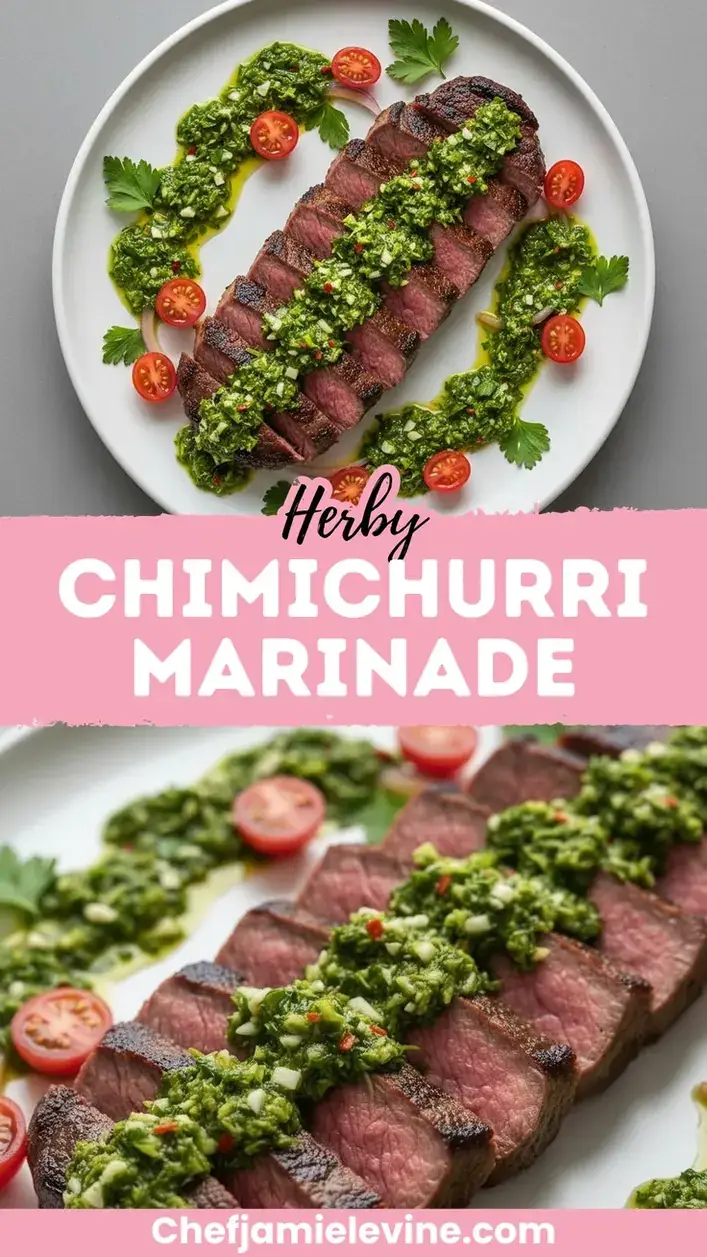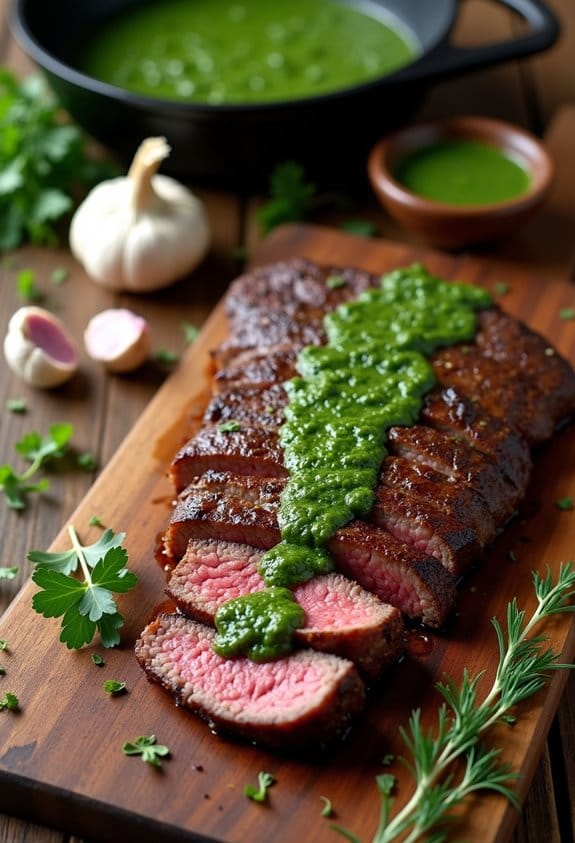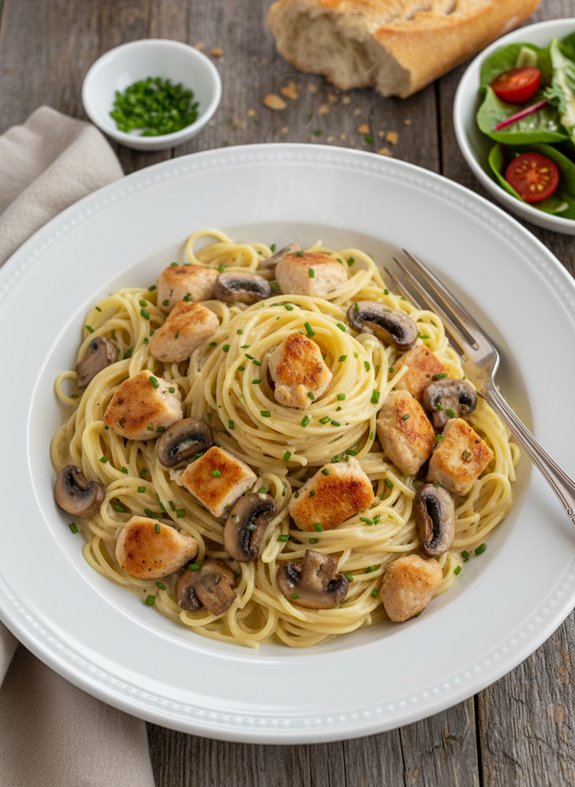Why You’ll Love this Chimichurri Steak Marinade
Three reasons you’ll love this chimichurri steak marinade: it’s incredibly versatile, packed with bright flavors, and takes just minutes to throw together.
I’ve tried countless marinades over the years, but this Argentine classic is my go-to when I want to transform an ordinary steak into something restaurant-worthy.
The vibrant herbs and garlic infuse your meat with incredible depth, while the vinegar gently tenderizes without turning the texture mushy.
Can’t find skirt steak? No problem. This works beautifully on everything from ribeye to chicken.
And unlike many marinades that require lengthy ingredient lists, you probably have most of these staples in your kitchen already.
What Ingredients are in Chimichurri Steak Marinade?
This vibrant green chimichurri marinade is truly the unsung hero of steak preparation. The beauty lies in its simplicity—fresh herbs, punchy garlic, good quality oil, and a splash of vinegar come together to create a sauce that both tenderizes and flavors your meat.
What makes chimichurri special is how it brings brightness to rich cuts of beef without overwhelming them, creating that perfect balance between the meat’s natural flavor and the marinade’s herbal notes.
- 1/2 cup finely chopped flat-leaf parsley (packed)
- 2 tablespoons fresh oregano (or 2 teaspoons dried oregano)
- 4 garlic cloves, minced
- 1/2 cup extra-virgin olive oil
- 1/4 cup red wine vinegar
- 1/2 to 1 teaspoon red pepper flakes (adjust to taste)
- 3/4 teaspoon kosher salt
- 1/4 teaspoon black pepper
- Optional boosters: 1/4 cup chopped cilantro, 2 tablespoons minced shallot, zest of 1/2 lemon
When selecting ingredients for your chimichurri, quality matters. Try to use fresh flat-leaf parsley rather than curly parsley for the best flavor, and don’t skimp on the olive oil—a good extra-virgin variety makes a noticeable difference.
If you’re sensitive to heat, start with just 1/4 teaspoon of red pepper flakes and adjust upward. And remember, this recipe is quite forgiving and adaptable.
Don’t have fresh oregano? The dried version works wonderfully too. Want to customize it further? The optional boosters can take this marinade in exciting new directions, particularly the cilantro which adds another dimension of herbaceous flavor.
How to Make this Chimichurri Steak Marinade

Making this vibrant chimichurri couldn’t be simpler, and the results are absolutely worth the small effort.
Start by whisking together ½ cup finely chopped flat-leaf parsley, 2 tablespoons fresh oregano (or 2 teaspoons dried if that’s what you have on hand), and 4 minced garlic cloves in a bowl. Add ½ cup extra-virgin olive oil and ¼ cup red wine vinegar, which creates that perfect balance of richness and tang. Sprinkle in ½ to 1 teaspoon of red pepper flakes (depending on how spicy you like things), ¾ teaspoon kosher salt, and ¼ teaspoon black pepper. Whisk everything until it resembles a loose pesto—not too thick, not too runny, just perfect for coating your steak.
Next comes the critical step that many people miss: taste and adjust. Is your chimichurri a bit too oily? Add another splash of vinegar. Lacking punch? A pinch more salt might be all it needs. Once you’ve got the flavor just right, set aside ¼ cup of the marinade for serving later—this is non-negotiable for food safety and guarantees you’ll have that fresh, vibrant sauce to drizzle over your cooked steak.
Place your steak (whether it’s skirt, flank, hanger, sirloin, or strip) in a dish or zip-top bag and coat it with the remaining chimichurri. Different cuts benefit from different marinating times: thinner cuts like skirt or flank need just 4-12 hours, while thicker cuts like sirloin can go 6-24 hours in the fridge.
When you’re ready to cook, take the steak out of the marinade, wipe off any excess (this is key for getting a good sear), and pat it dry with paper towels. You might want to lightly oil and salt the steak if needed.
Then sear or grill it over high heat to an internal temperature of 125-130°F for medium-rare, which typically takes about 2-4 minutes per side depending on thickness. The most important final touches? Let that beautiful steak rest for 5-10 minutes before slicing thinly against the grain.
Drizzle with your reserved chimichurri sauce, and watch everyone’s eyes light up when they take their first bite. Food safety reminder: never reuse marinade that’s touched raw meat unless you boil it for at least 2 minutes first.
Chimichurri Steak Marinade Substitutions and Variations
While traditional chimichurri delivers vibrant flavor, don’t hesitate to make this recipe your own with easy substitutions and creative variations.
I often swap half the parsley for cilantro when I’m craving something more citrusy, or add a spoonful of minced shallot for subtle sweetness.
No fresh oregano? Dried works perfectly—just remember to use less.
And for those who can’t handle heat, start with just a pinch of red pepper flakes.
My secret weekend twist? Adding lemon zest brightens everything up.
Trust me, it’s worth trying on chicken or shrimp too, not just steak.
What to Serve with Chimichurri Steak Marinade
A perfectly grilled steak dripping with chimichurri deserves companions that complement rather than compete with its bold, herbaceous flavors.
I love serving mine with simple roasted potatoes tossed with a touch of the sauce, or a crusty bread to soak up every last drop.
For a complete meal, try a bright arugula salad with lemon vinaigrette, grilled corn on the cob, or even charred bell peppers.
Looking for something heartier? Chimichurri and creamy polenta are magical together.
And don’t forget a glass of Malbec—its fruity notes stand up beautifully to the tangy, garlicky marinade.
Final Thoughts
Once you’ve mastered this chimichurri steak marinade, you’ll never go back to bottled sauces again.
I’ve been making this recipe for years, tweaking it until it’s absolutely perfect—bright, herbaceous, and zingy with just the right kick.
What I love most is how versatile it is. Make a double batch and use it throughout the week on everything from grilled chicken to roasted vegetables.
The flavors actually deepen after a day in the fridge, which is why I always keep some on hand. Trust me, your dinner guests will be begging for the recipe.

Chimichurri Steak Marinade
Ingredients
Equipment
Method
- In a bowl, combine the finely chopped parsley, fresh or dried oregano, and minced garlic.
- Add the extra-virgin olive oil and red wine vinegar to the herb mixture.
- Sprinkle in the red pepper flakes, kosher salt, and black pepper. Whisk everything until it resembles a loose pesto consistency.
- Taste the chimichurri and adjust seasonings if needed. Add more vinegar if too oily, or more salt if lacking flavor.
- Set aside ¼ cup of the marinade for serving later (important for food safety).
- Place your steak in a dish or zip-top bag and coat it thoroughly with the remaining chimichurri.
- Marinate thinner cuts (skirt or flank) for 4-12 hours, or thicker cuts (sirloin) for 6-24 hours in the refrigerator.
- When ready to cook, remove the steak from the marinade, wipe off any excess, and pat dry with paper towels.
- Lightly oil and salt the steak if desired before cooking.
- Sear or grill the steak over high heat to an internal temperature of 125-130°F for medium-rare, approximately 2-4 minutes per side depending on thickness.
- Let the steak rest for 5-10 minutes before slicing thinly against the grain.
- Drizzle with the reserved chimichurri sauce and serve immediately.



